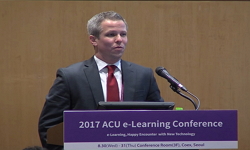목적 본 연구는 고등교육 환경에서 교수자들이 학습자중심 테크놀로지 통합교육을 효과적으로 실현할 수 있도록, 비판적 문헌 분석을 통해 기존의 테크놀로지 통합모델을 평가하고, 교수 ...
http://chineseinput.net/에서 pinyin(병음)방식으로 중국어를 변환할 수 있습니다.
변환된 중국어를 복사하여 사용하시면 됩니다.
- 中文 을 입력하시려면 zhongwen을 입력하시고 space를누르시면됩니다.
- 北京 을 입력하시려면 beijing을 입력하시고 space를 누르시면 됩니다.
https://www.riss.kr/link?id=A109744524
- 저자
- 발행기관
- 학술지명
- 권호사항
-
발행연도
2025
-
작성언어
-
- 주제어
-
KDC
373
-
등재정보
KCI등재
-
자료형태
학술저널
-
수록면
989-1005(17쪽)
- 제공처
-
0
상세조회 -
0
다운로드
부가정보
국문 초록 (Abstract)
방법 본 연구는 학습자중심 테크놀로지 통합교육의 개념을 정립하고, 이를 평가하기 위한 TIM(The Technology Integration Matrix) 모델을 활용하여 국내 고등교육 현장에서의 사례를 분석하였다. KCI 데이터베이스를 활용하여 3차례에 걸친 분류 및 분석 작업을 통해 고등교육 학습자중심 테크놀로지 통합교육 관련 논문을 총 16편을 선정하였으며, TIM 모델이 제시한 다섯 가지 테크놀로지 통합 수준과 다섯 가지 학습환경 형태를 평가하였다.
결과 대부분의 사례는 테크놀로지 통합의 도입 또는 차용 수준에 머물러 있었고, 여전히 교수자 중심의 지식 전달 도구로 한정되어 있어 최상위 수준인 변혁적 테크놀로지 통합과 거리가 있었다.
결론 이를 극복하기 위한 대안으로 교수자는 고차원 학습 활동을 가능하게 하는 학습 목표 설정, 자기주도적 학습 환경 설계, 과정중심 평가 도입, 그리고 체계적인 LMS 활용 방안의 필요성을 제안한다. 또한 강의계획서에 테크놀로지 통합 계획과 전략을 포함하여 수업 단위에서 진정한 학습자중심교육의 실현을 제안한다.
목적 본 연구는 고등교육 환경에서 교수자들이 학습자중심 테크놀로지 통합교육을 효과적으로 실현할 수 있도록, 비판적 문헌 분석을 통해 기존의 테크놀로지 통합모델을 평가하고, 교수 지원 프로그램의 평가 체계 확립을 위한 방향을 제시하고자 한다.
방법 본 연구는 학습자중심 테크놀로지 통합교육의 개념을 정립하고, 이를 평가하기 위한 TIM(The Technology Integration Matrix) 모델을 활용하여 국내 고등교육 현장에서의 사례를 분석하였다. KCI 데이터베이스를 활용하여 3차례에 걸친 분류 및 분석 작업을 통해 고등교육 학습자중심 테크놀로지 통합교육 관련 논문을 총 16편을 선정하였으며, TIM 모델이 제시한 다섯 가지 테크놀로지 통합 수준과 다섯 가지 학습환경 형태를 평가하였다.
결과 대부분의 사례는 테크놀로지 통합의 도입 또는 차용 수준에 머물러 있었고, 여전히 교수자 중심의 지식 전달 도구로 한정되어 있어 최상위 수준인 변혁적 테크놀로지 통합과 거리가 있었다.
결론 이를 극복하기 위한 대안으로 교수자는 고차원 학습 활동을 가능하게 하는 학습 목표 설정, 자기주도적 학습 환경 설계, 과정중심 평가 도입, 그리고 체계적인 LMS 활용 방안의 필요성을 제안한다. 또한 강의계획서에 테크놀로지 통합 계획과 전략을 포함하여 수업 단위에서 진정한 학습자중심교육의 실현을 제안한다.
다국어 초록 (Multilingual Abstract)
Methods This study argues for learner-centered technology integration education and analyzes its practical application in Korean higher education using the Technology Integration Matrix (TIM) model. A total of 16 studies related to learner-centered technology integration education in higher education were selected from the KCI database after the three stages of a sorting process. These studies were evaluated based on the five levels of the technology integration and the five characteristics of the learning environments defined by the TIM model.
Results The results revealed that most cases remained at the entry or adoption levels of technology integration, still confined to teacher-centered tools for knowledge transmission, and fell short of achieving the transformative level of technology integration.
Conclusions To address these limitations, this study proposes alternatives such as setting learning objectives that enable higher-order learning activities, designing self-directed learning environments, implementing process-oriented assessments, and adopting systematic approaches to utilizing Learning Management Systems (LMS). Furthermore, it recommends incorporating technology integration plans and strategies into course syllabi, thereby facilitating authentic learner-centered education at a course level.
Objectives This study aims to enhance the quality of learner-centeredness in higher education by critically analyzing technology integration models and developing an evaluation framework for faculty support programs. Through the analysis and framewor...
Objectives This study aims to enhance the quality of learner-centeredness in higher education by critically analyzing technology integration models and developing an evaluation framework for faculty support programs. Through the analysis and framework, the study seeks to provide strategic directions for effectively implementing learner-centered technology integrated education.
Methods This study argues for learner-centered technology integration education and analyzes its practical application in Korean higher education using the Technology Integration Matrix (TIM) model. A total of 16 studies related to learner-centered technology integration education in higher education were selected from the KCI database after the three stages of a sorting process. These studies were evaluated based on the five levels of the technology integration and the five characteristics of the learning environments defined by the TIM model.
Results The results revealed that most cases remained at the entry or adoption levels of technology integration, still confined to teacher-centered tools for knowledge transmission, and fell short of achieving the transformative level of technology integration.
Conclusions To address these limitations, this study proposes alternatives such as setting learning objectives that enable higher-order learning activities, designing self-directed learning environments, implementing process-oriented assessments, and adopting systematic approaches to utilizing Learning Management Systems (LMS). Furthermore, it recommends incorporating technology integration plans and strategies into course syllabi, thereby facilitating authentic learner-centered education at a course level.
동일학술지(권/호) 다른 논문
-
유학생의 자기효능감과 자기결정성이 한국어 능력에 미치는 영향: 한국에 대한 신뢰감의 조절 효과
- 학습자중심교과교육학회
- 차춘동(Chun Dong Cha)
- 2025
- KCI등재
-
국내 대학생의 학업소진 관련 변인에 대한 메타분석: 보호요인과 위험요인을 중심으로
- 학습자중심교과교육학회
- 김유선(Yoosun Kim), 유금란(Kumlan Yu)
- 2025
- KCI등재
-
보육교사의 직업선택동기와 직업존중감이 재직의도에 미치는 영향
- 학습자중심교과교육학회
- 안선희(Sun Hee Ahn), 조서연(Seo Yeon Cho)
- 2025
- KCI등재
-
찾아가는 생활체육 서비스 뉴스포츠 프로그램 참여 지적장애 학생의 학교생활 및 생활체육 만족도 분석
- 학습자중심교과교육학회
- 박수림(Su-rim Park), 이민기(Min-gi Lee)
- 2025
- KCI등재
분석정보
연관 공개강의(KOCW)
-

AI시대의 고등교육, 어떻게 해야 할까
신한대학교 신종우 -

종합토론 : 고등교육 혁신지원을 위한 대학원격교육지원센터(UDEC) 발전 방안
한국교육학술정보원 이태억, 김정숙, 김현철, 박주병, 서순식, 장상현 -

2017 ACU 이러닝 국제 콘퍼런스
한국교육학술정보원 션 코너(Sean Connor), 아베리노 메지아(Avelino A. Mejia Jr.), 멜린다 델라페나 반달라리아(Melinda dela Pena Bandalaria), 가또 하리 쁘리오잔또 -

글로벌 인재포럼 2007: 고등교육의 질 관리
글로벌 인재포럼 Barbara Ischinger,, Peck Cho, Director, Roger Benjamin -

2011 Asian and Africa Womens conference
숙명여자대학교 한영실





 스콜라
스콜라

